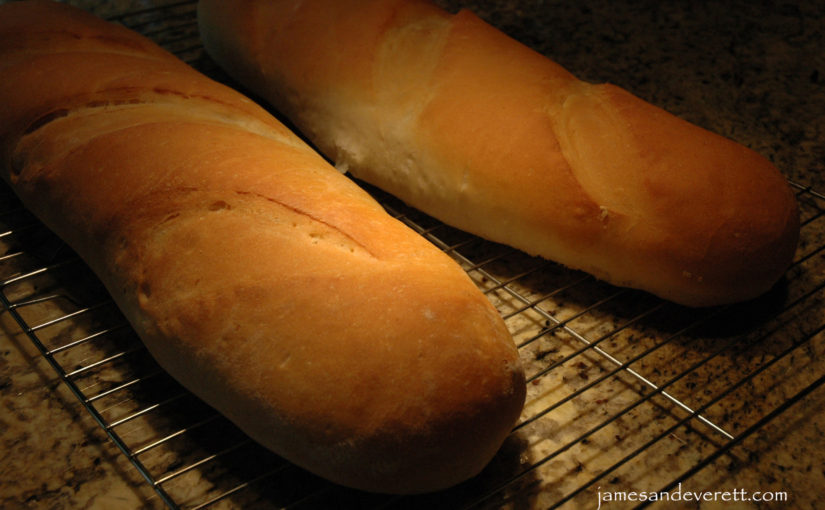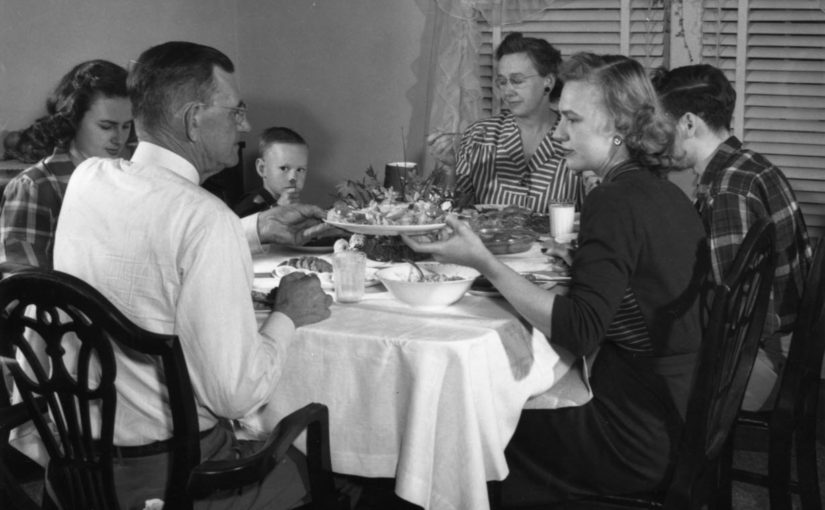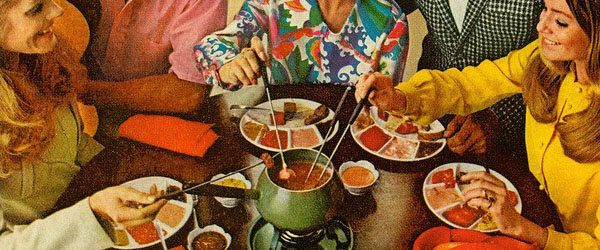Everyone, most especially Americans, know about bread. It is an American staple. We simply cannot picture a meal without bread. Breakfasts have toast. Lunches consist of either a sandwich or a hamburger. Dinners usually have some kind of bread, whether it is a loaf of white bread or some dinner rolls. The point is that we, as Americans, consider bread to be an important part of our day to day meals.
As such, we don’t appreciate bread.
We take it for granted. We buy loaves of pre-sliced bread off the store shelves. We eat hamburgers using preserved hamburger buns. We eat hotdogs using a package of pre-made hotdog buns. Dinners use (at best) instant frozen buns. We never really give any thought to the IMPORTANCE of having fresh, crusty bread served daily.
I would like to talk about this…
Growing Up
When I was a little boy, we (of course) ate bread. My mother would pack us a sandwich made out of white bread (usually Wonder Bread) and put it in a little lunch box that I would carry to school with me. I had a couple of lunch boxes over the years. I had a Flintstones, a Diver Dan, a Fireball XR5, and a Jetsons lunch box. I even had a Beatles lunch box, but I gave it to my sister as she really wanted it.
Each lunch box would have a small thermos inside. My mother would fill it with soup. We would have various kinds of soups. Almost all the time they were Campbell’s soups. We typically have tomato, chicken noodle, chicken rice, vegetable, and beef vegetable soups.
The sandwich would be either a baloney, ham, chicken salad, egg salad or peanut butter and jelly sandwich. It would always be cut diagonally into two halves. It would be packaged within a plastic bag and sat there with a napkin, and a piece of fruit; usually an apple. Other fruits included bananas, peaches, plums, grapes or a box of raisins.
At that time, I really didn’t know much about food. I grew up with white-bread sandwiches and didn’t give them a moment’s thought. My sister and brother, on the other hand, had very strong feelings about the bread used. It just HAD to be “Wonder Bread” brand of sliced bread. They absolutely refused to eat anything other than that particular brand of bread. Eh? Who figures?
Dinners were always served with bread. Typically it was also white bread. My mother would place the plastic wrapped loaf on the table and we would help ourselves to whatever bread we wanted. Butter was always on the table in a rectangular glass dish. For the most part, it was salted butter, but she switched to margarine because the cost of butter was getting too expensive for casual family use.
She would make homemade bread on major holidays such as Christmas, Easter, and Thanksgiving. She would also buy frozen rolls from Pillsbury, and bake them in the oven.
For me, my experience with “real” fresh bread and rolls occurred when I visited my grandparents in Pittsburgh. For there, they had access to bakeries. We didn’t as we lived in the country.
Bakeries
Both of my grandparents lived in the suburbs of Pittsburgh. One was on “Polish Hill” which was a hill overlooking the “main drag” of Pittsburgh known as Liberty Avenue. The other set of grandparents lived in Lawrenceville. It was a Northern suburb that served various industries up-river.
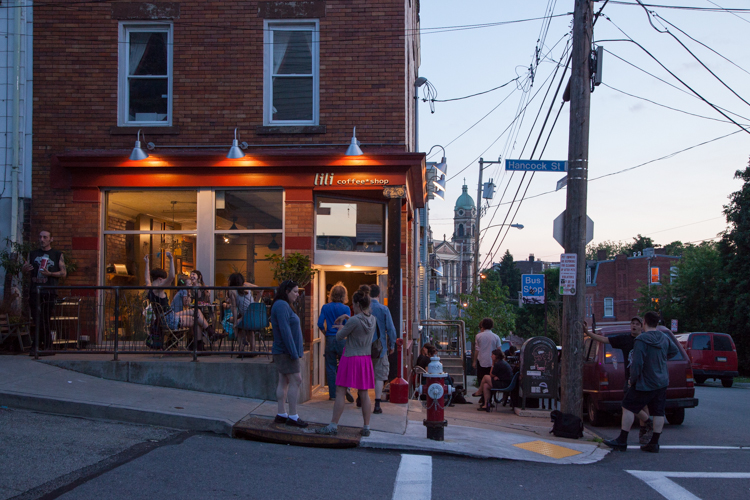
Polish Hill was great. It was settled by immigrants from Poland and it had a kind of old-world European flavor to it. I was just about related to everyone there. There were various bars, bakeries, grocery stores, and small family run establishments up and down the streets. Of course, the Catholic Church dominated the hill, and the Polish Falcons club was on a side street.
There was a bakery that was just down the street. On the weekends, my grandmother would walk down and buy two dozen hard rolls. Thus, when we would visit them, we could eat our fill of fresh hot hard rolls and salted butter. She would get a selection of rolls that would include poppy seed, sesame seed, onion, and salt rolls that we could choose from. Typically, I would eat them with good strong black coffee that I used to drink with sugar and cream.
If we were having a brunch, she would lay out some cold cuts. We would then make us a sandwich out of the hard rolls and the cold cuts. She (well, both of my grandmothers) would lay out a “spread”. This would include fresh Lettuce, onion, sliced tomatoes and a big jar of Miracle Whip or mayonnaise. We would them make us a sandwich from those fixings. It would end up something like this;
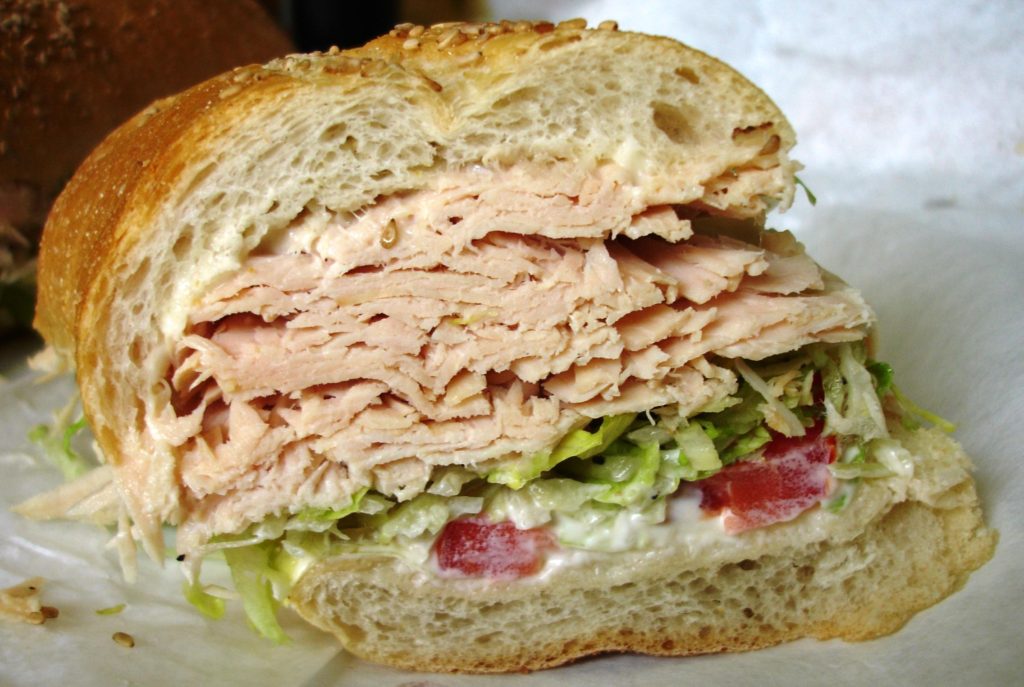
Lawrenceville was similar. They also had a couple of bakeries that they would frequent. However, instead of buying rolls they would buy a loaf or two of bread and have the bakery slice it for us. Typically an Italian loaf, a thick loaf of Rye bread, or a crusty black loaf were what my other grandmother would buy.
In this case, the sliced loaves would be laid out on the table and we could make sandwiches out of the slices. The layout was similar, except there would also be pickles, olives, coleslaw, homemade potato salad, sausage, mustard, and horseradish on the table. For some reason, my relatives from that side of the family really liked to make sandwiches with coleslaw on it. I have tried it a number of times and I must admit that it really was quite tasty.
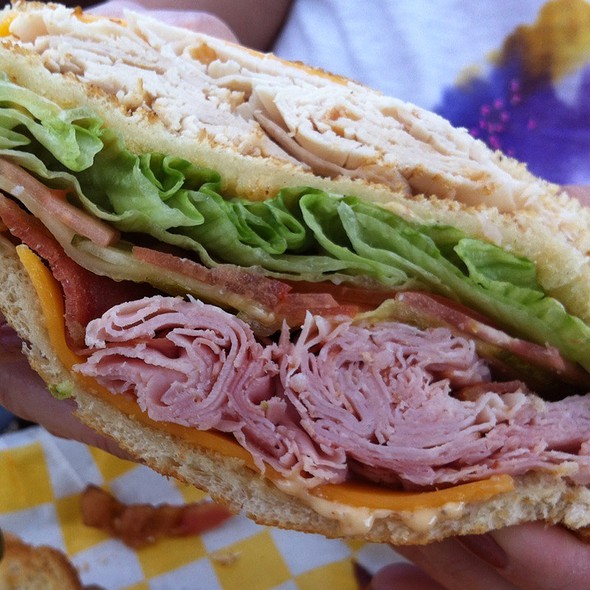
Both grandparents had different ways of doing things. My grandparents from Lawrenceville would lay out a spread, and the entire family would sit around playing cards, snacking, and chatting. Us kids would be running around in the back alleys and jumping from rooftop to rooftop over the narrow alleys. (My mother lost her 14-year-old sweetheart that way; he fell and died when he didn’t make it to the other roof.) We would go down into the basement and get a bottle of soda and continue playing.
My grandparents on Polish Hill would do things differently. There it was coffee, buttered rolls, newspapers, and television. We could go out and play. Typically, I would go out with my cousins and hang out at their homes, listening to 45 records on record players, and reading comic books. Like all homes (well, maybe most homes) there was always a case or two of glass bottled soda (in a wooden box) sitting on the basement stairs for us to get at will and drink.
There was something else too. For some mysterious reason, most basements in Pittsburgh had a commode sitting in the middle of the basement floor. (Read more about it HERE, HERE, HERE, and HERE.) Which was handy if you needed to go to the bathroom, but uncomfortable as it was like taking a dump in the middle of a basketball court.
“The "Pittsburgh Shitter," as I've heard it called -- and not just when readers suggest alternate names for CP -- is a treasured bit of local folklore. Basement toilets have long been celebrated as a connection to the city's industrial legacy; they've even been featured in Rick Sebak's recent documentary Underground Pittsburgh. "The story is that you came home from work in the mill, and you used the basement to wash up before you tracked grime all over the house," says Ron Baraff. An archivist and historian at Homestead-based Rivers of Steel, it's Baraff's job to delve for local working-class history. Obviously, he finds it in a lot of basements. Frequently, he says, "If you go into these older homes, there's often a cast-cement tub down there as well. I have heard from dozens of steelworkers and their families that this was the daily routine -- especially before the 1950s, before there were big shower rooms installed in the plants themselves." Still, he says, while the bathrooms are rare, they are not unheard of: "I know of other towns where people have the same sort of thing. You tend to find them in a lot of working-class towns" -- including Cleveland, where a toilet in the basement arguably seems a little redundant. But "there are older towns in Oregon where they have them as well," Baraff says. Pittsburgh's basement toilets are somewhat unusual, Baraff allows, because they very often don't feature amenities like, well, walls. "They're just right out in the open. It's the fact that they are stand-alone facilities, with no walls or anything else.” -Chris Potter

It might not be politically correct, but up until the 1960’s and 1970’s, men (in Pittsburgh) had their own areas or domains. As did their wives and the ladies in their lives. The women had control over the “upstairs” bathrooms, the kitchen and the laundry room. The men had control of the “basement” bathroom, the work area, and the storage area. Everything else was shared.
It worked out well that way. The woman folk always had the bathrooms clean, tidy and sanitized. The menfolk would have privacy and peace in their own bathrooms.
Ah. Today is a different time, and we have forgotten the workaround that older generations used to cohabitate together. Today we think that everything was equally shared and equally maintained. Ha! No such chance. The men had their own areas, and the women had their own areas.
My Own Experiments
I have to say that as much as I enjoy eating bread, my attempts to make it have been abject failures. I would follow the instructions. I would add the yeast properly, and pound and knead the dough just like the instructions said. I would let it rise and then put it in the oven. Yet…
Yet…
They never seemed to come out as good as the hard crusty loaves of bread that we could get at the bakery.
They were bread. That much was clear. They smelled like bread, they even tasted somewhat like bread. But they weren’t the tasty loaves that I could buy at a bakery. What was I doing wrong? I have never been able to figure it out. I followed the instructions, but each time I did it, the loaves just turned out…um, plain.
The bread never became hard and crusty. The nice big pockets of air never materialized. The taste was never, at all, like what I was expecting. Ah, this was a big disappointment. Let me tell you.
I know that it is a big disappointment when my dog just sniffs it and then turns his back and walks away from it. I know that there is something wrong when my wife refuses to be in the house with me when I am making the bread. She can’t stand to see all the mess and the big disappointment on my face when the loaves are finished. I know that it is a big disappointment when I try to give it away to my staff, and then they go around and just throw it away in the trash can.
I guess that baking bread isn’t one of my strengths. Sigh.
Hamburger & Hotdog Buns
Let’s chat a little bout hotdog buns and hamburger buns. You know one of my favorite quotes is from the movie True Stories (This is not the “Bulletproof Monk” quote. They stole it from the original movie.);
"It's like how hot dogs come in packs of 10, and buns come in packs of eight or 12 - you have to buy nine packs to make it come out even." -Quotes from "True Stories"
I remember watching this movie for the first time. It was during my MAJestic training at China Lake. I was living in Ridgecrest, California at the time, and when I would leave the base after a day of training in the “chamber”, I would come home to beer and watch a movie rental. I believe we watched it in BetaMAX at the time.

Anyways…
You know, even though I grew up with them all my life (hotdog and hamburger white bread rolls), I really don’t think that they are all that good. Certainly, the rolls can be improved somewhat. If you eat them alone it is like eating a rather bland sponge.
Don’t you think?
The simple truth is that a hamburger bun at the grocery store is the same as a hamburger bun at a cub scout gathering, a picnic, a McDonald’s restaurant, or a typical diner. They are all the same. There is nothing special about it, and no special attention is given to the selection of the bun.
It’s a shame. It’s really sad.
Portuguese Rolls
Which brings me to the joy of eating “Portuguese Rolls”.

You know, I was first introduced to the joys of Portuguese Rolls while I was living in Milford, Massachusetts. There, in the surrounding area, was a sizable community of immigrants from Portugal. The town of Milford was really quite nice. When I lived there, it was in the mid to late 1990’s and it still had the Mayberry RFD “feel” about it.
There were numerous bakeries there. I would get to eat fresh rolls, bagels, Italian bread, and of course, Portuguese Rolls.
I remember the event quite clearly. We were making up a crock-pot full of sweet Italian sausages with cut up onions, peppers, and tomato sauce. We added some basil, garlic and some oregano for flavor and let it cook away for around five hours or so.
Ah… the house smelled marvelous.
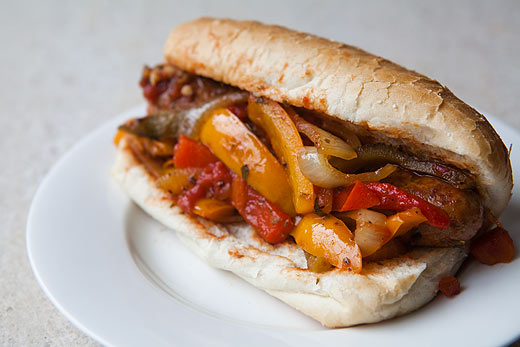
We had bought some Portuguese Rolls from the bakery, and we thought they might be good with the sausages. Boy was we in for a treat! The rolls were tough and crunchy on the outside, but warm and moist on the inside. They were not circular like a normal hard roll would be. Instead, they were more like a football shape. They were also a little small.
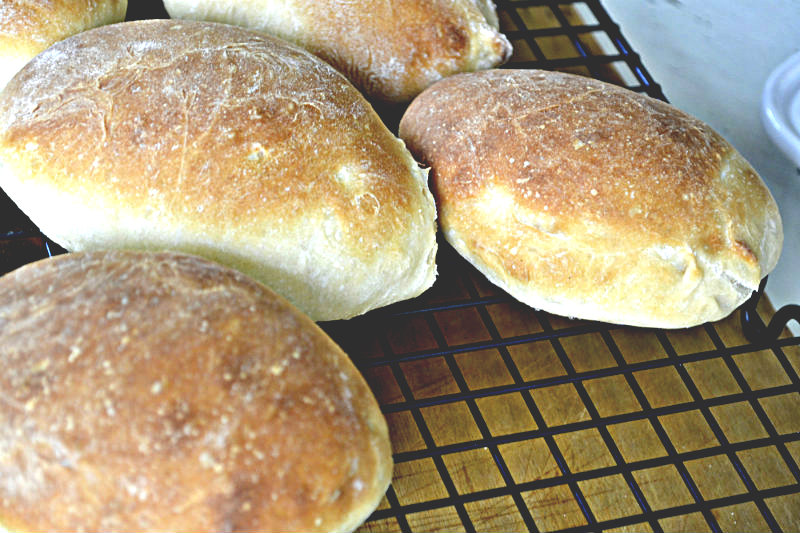
I fell in love with them the first time that I tried them. They were so absolutely delicious. It was sort of like eating a hard roll, except that the skin was just a little bit crunchy. That, and the skin ran deeper. It was thus, a little chewier. It was amazing when you coupled it with the sweet Italian pepper sauce. Yum!
Fresh Baked Italian Bread

I have always enjoyed freshly baked bread. In fact, my favorites have been both French and Italian baked loaves of bread. Of course, that is pretty difficult to come by outsides of Europe, though there are some pretty good bakeries around the world.
One of the best moments that I ever had regarding fresh loaves of bread occurred in the tiny town of Lli’ili (yeah, it’s a pretty odd name) on the island of Tutuila in American Samoa. I was there working as a Project Engineer building a medical complex near Pago Pago. After the day’s work, we would hop into the truck and drive to the market and get some beer. We could get it at just about any small store, but we liked to go to our favorite grocery store.
We would go get our groceries from a market in Lli’ili. They had a pretty big selection of food, which was pretty hard to come by (and expensive) since we were living on a remote and distant island in the middle of the South Pacific.

Every day they would bake fresh Italian bread. Fresh. When you pulled in from the road and walked into the grocery store, your nostrils would fill up with that wondrous aroma.
My wife, Chinese, has never been a big fan of bread. She buys them and eats them with me. However, for her, she prefers seafood such as conchs, and snails. (After all these years, I eat them, but they are not my favorites.) Yet, when she tried this bread she fell in love with it. It was so delicious and tasty. We ate it with real salted butter. The butter would melt inside the soft white moistness of the warm interior. It was delicious and so wonderful.
We went and bought two loaves, and scarfed them both down with Ice cold Valima beer.
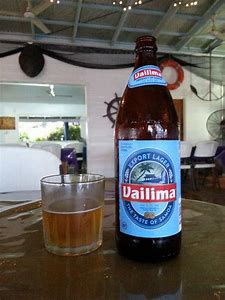
Bread in China
Speaking of my wife’s preferences in food, are you aware of what constitutes bread in China? Yeah. It’s quite different than what is “real” bread back in the States, or out in Europe.
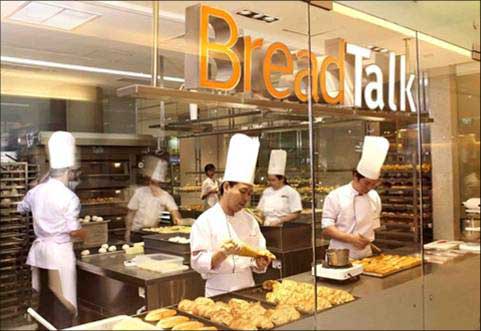
Yes, they do have bakeries. Yes, they also carry a wide selection of loaves of bread, pastries, and confections. Bakeries are actually a pretty common thing in China. You actually can’t visit a town or city without running into one every other city block.
In general, Chinese bread is typically [1] sweet, and [2] very soft. It is like eating sponge cake. That is pretty much what it is like. Imagine sponge cake made into rolls, biscuits, cakes, cookies, and long loaves of bread.
Imagine each bread or pastry having different flavors as well. While there are the common flavors such as cherry, blueberry, lemon, banana and other well-known fruit sensations, they also have other tropical flavors to suit the Chinese palate. They have durian, mango, papaya, guava, and star-fruit flavors as well. Of course, they also carry a wide selection of cakes.
One of the odd things about Chinese bakeries is that they tend to use this kind of strange pork dust flakes that they really like to sprinkle on everything. They especially like to sprinkle it on loaves of bread. So you can get a cherry flavored (sponge cake) bread, for instance, with pork flakes on top of it. Who’d figure?
It’s odd, I know.

No pies though. It’s difficult to get a pie in China. The closest thing to a pie is at McDonald’s fast-food franchise. There you can get a McDonald’s red bean pie, instead of (the American staple) an apple pie.
There is good news, however. Most bakeries in China do know how to make long French bread. Most will have this kind of hard bread on sale. The typical cost varies from 6 yuan (approximately $1) for a loaf all the way up to 12 yuan ($2) at the more expensive stores.
Fresh Italian Bread with Dinner
Now with this in mind, we typically buy a loaf or two at the store. We cut it up and put it in the freezer to eat with our dinner. Not every meal that we eat is a Western meal, so we typically only eat the bread with a “Western Style” meal.
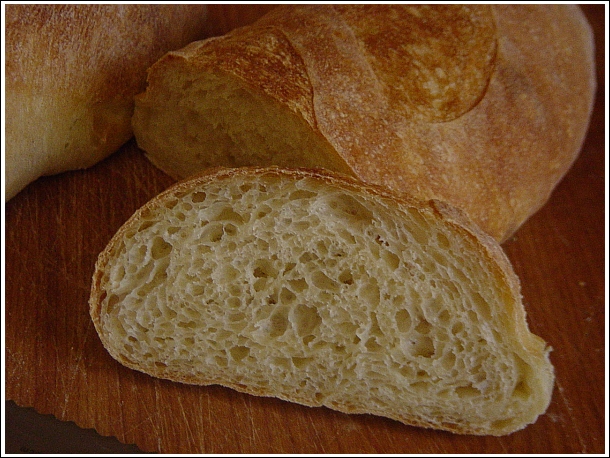
If the meal is Western, it is served with bread. We buy a loaf or two of “French bread” from the local supermarket (D, RenRen Le, Carrefour, Taste or Park n’ Shop). There they make “real” crusty bread, not the super soft sweet bread that is so common in Chinese bakeries. Typically we purchase it beforehand when it is made fresh and then we freeze it. We take it out and heat it up in the oven or microwave as necessary.
Salted Butter. We eat bread with REAL SALTED butter. This is one of the little pleasures that I missed over the years. In the rush to make everything “healthy” in the United States, everyone switched to unsalted butter and margarine. Bullshit. You lose the taste, and you still die early. It’s all nonsense. In my house, we cut the bread, heat it up in the oven, and place it in a bowl covered under a cloth. It is served with the formal family meal.
The selection (and presentation) of butter is very important. The butter is in a large glass butter container (twice the size of the one we had as I grew up in the 1960’s) and is left out for a few hours to soften up. Butter is ALWAYS “salted” butter (which we buy on the internet), in a pinch, we will use “lightly salted”. We absolutely never use “unsalted” butter.
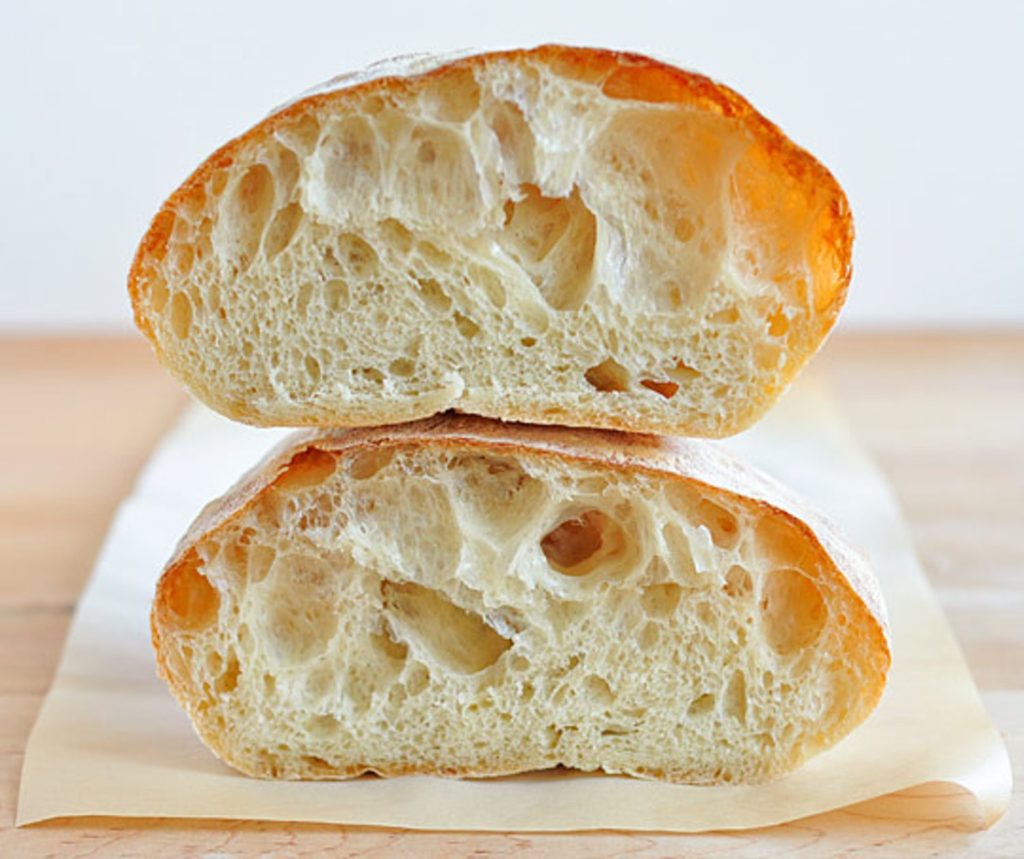
Hard Crusty Rolls on a Sunday
Back in the day, I went to Syracuse University to study Aerospace Engineering. When I was attending university, I lived off campus. I lived on the “East Side” of Syracuse in the “German Section” of South Salina street. This area was a cultural enclave of German immigrants who moved to Syracuse from Germany. At that time, I lived with a German family who rented a room out to me.
They were good folk. Heinz came to the United States with his wife Gertrude after the collapse of Nazi Germany after World War II. He was hard of hearing because of a war wound. (He was a military police officer on the Russian front.)
Ah, the stories they would tell me! They would talk about the collapse of society and the war. Gertrude would tell me about the awful, awful things the Russian soldiers would do to the German girls, and Heinz would tell me about the struggles that they had escaping from Germany during the collapse.
Heinz had built a secret room in the basement behind a fake set of shelves. He told me that you should never expect things always to be good and great; that you should always prepare for the worst. He kept a couple of firearms in the house in hidden locations, and always made sure that the “emergency safe room” was always stocked up and safe. Now, as far as I know, he never ever needed to use that room. Good thing, I am sure.
Anyways…
Every morning I would get a fine German breakfast. It consisted of toasted bread, peanut butter, cut up lettuce, tomato, and onions. I would also get a soft boiled egg and some coffee. It was actually very delicious. Sometimes there would be some liverwurst that I could spread on top of the toast. It has become one of my fondest memories.
Now the bread was just normal store-bought bread. Sometimes, it would be a rye or a wheat bread. However, for the most part, it was a plain white “everyday” bread.
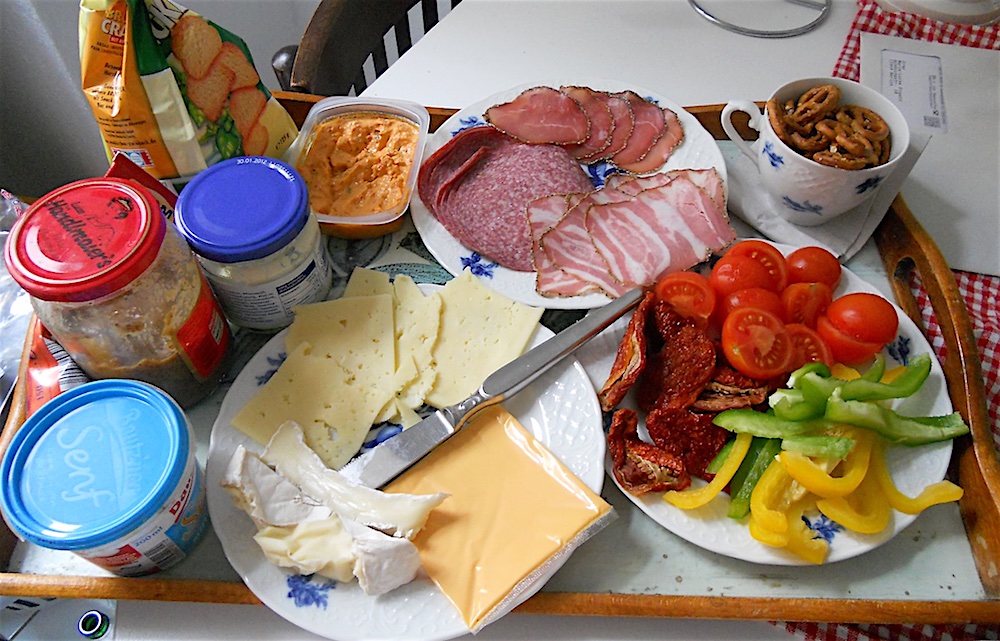
They always gave me a great breakfast. I would take my time making the toast and putting all kinds of things on the bread. It was most certainly delicious.
However, for some reason, Sundays were different. Gertrude liked to watch a religious television show at the time. I think it was called the 700 club. During the show, I think it ran all the time, but on Sundays, she was “glued” to the set in the living room. As such, she couldn’t make me my regular or “normal” breakfast meal.
Instead, she or Heinz would bring a paper bag of hard rolls from the neighborhood bakery and place them on the table. I could help myself to a few rolls, some sliced tomatoes, butter, cream cheese, and coffee. It wasn’t the same as the regular German breakfast spread, but it was just as nice.
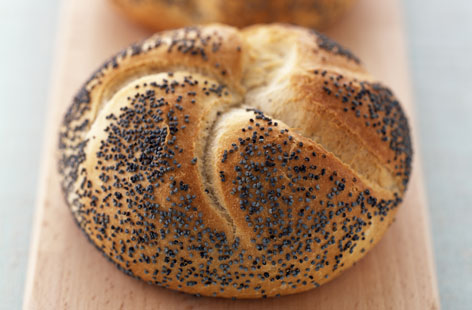
In fact, I must confess, I have taken a real liking to hot hard rolls with real salted butter, and fresh (from the garden) tomato slices with salt and pepper. Thus, the reason for this post, don’t you know. You just cannot get these rolls here in China. It is simply not possible. As such, it is one of those little pleasures that I have come to miss terribly.
The Importance of a Local Bakery
So what is more important, having fresh hard loaves of bread or being able to go next door and get them? Well, you would think that (of course) bread is a food that you eat. So, therefore, to eat the bread is the most important thing. I disagree. I think that the most important aspect of having a good, high-quality meal, is to have a local bakery in your neighborhood nearby.
Forget about all that “modern” 1930’s gibberish about the “new, modern and progressive” life. It never materialized. Forget, also, the siren song of the convenience of the 1960’s. It materialized and ended up as a horrible out of control monster.
The lofty dreams of the idealists got us tomatoes that taste like water-filled cardboard, plastic wrapped bread that tastes like a clean mop head, and fake butter that makes your face break out in pimples. Oh, but they meant well…
The best and most important aspect of personal satisfaction is how we control our lives. That means ourselves and of our families. We need to have a stress free life. We need to have a life that is filled with happiness and contentment. We need to have a life that is filled with good things, and one that is all around us. Yes, we need to have a life where those things that matter to us surround us.
yes, we need to have a bakery nearby.

Bagels
Now speaking about bakeries, let’s talk about the joys of bagels. Now that is one food that I haven’t eaten in years. Literally…years!
You just cannot find bagels in China. Not commonly, that is. There was a small expat bakery in Shekou (a suburb of Shenzhen) for a while. They made bagels. I also heard that you can get bagels in some of the more upscale regions of Shenzhen. However, real and fresh bagels have eluded me. Ah, this is such a shame.

When I was in Boston, I couldn’t walk five feet without running into a bagel. (Well, obviously that is an exaggeration.) However, it is true that you could get them just about anywhere. They were good, hot and FRESH. There is nothing so tasty as a fresh hot bagel with creme cheese. Of course, I would drink it down with some coffee. Ah, good times. Good times.
Peanut Butter Bagel with Peanut Butter
One of the most amazing experiences that I had (and one that I will never forget) was when I went through a drive-through at a bagel hut (sort of like a Pizza Hut, only for bagels) and ate a fresh hot peanut butter bagel with slathered peanut butter. My God! It was like I died and went to peanut butter heaven!
Who figures? Right?
After that most amazing experience, I started to go to the company cafeteria where I worked. I would order a toasted bagel with butter and creme cheese as a mid-breakfast snack. Now, of course, this was just a pale reflection of the “real thing”. The butter was actually unsalted margarine (for the employee health), the bagels were store bought in bulk and not crusty at all, and the peanut butter was generic (not Jif). It wasn’t really all that good, but you make do…
Which is the point behind all this discussion…
We tend to accept things as they are and don't fight for the Little things that really matter to us. We accept things blindly without even thinking about them. We don't miss the good things in life, because we have forgotten their importance to us. When we do actually remember their significance, we tend to substitute cheaper (and pale) alternatives blindly. We fail to realize that the substitution degrades the value of our experience.
Crumpets (English Muffins)
I always liked “English Muffins”. My mother would buy them from the grocery store. It was all that I knew. They would come packaged in a plastic wrapped rectangle. Inside the bag would be six muffins that were about the size of an open hand palm.
They toasted really nice. The butter would melt on them quite readily and they were delicious.
Later, when I would go on business trips with my father (I could go on selected trips in my early teens) we might stop at a restaurant and get an “eggs benedict” which would be a poached egg on an English muffin.
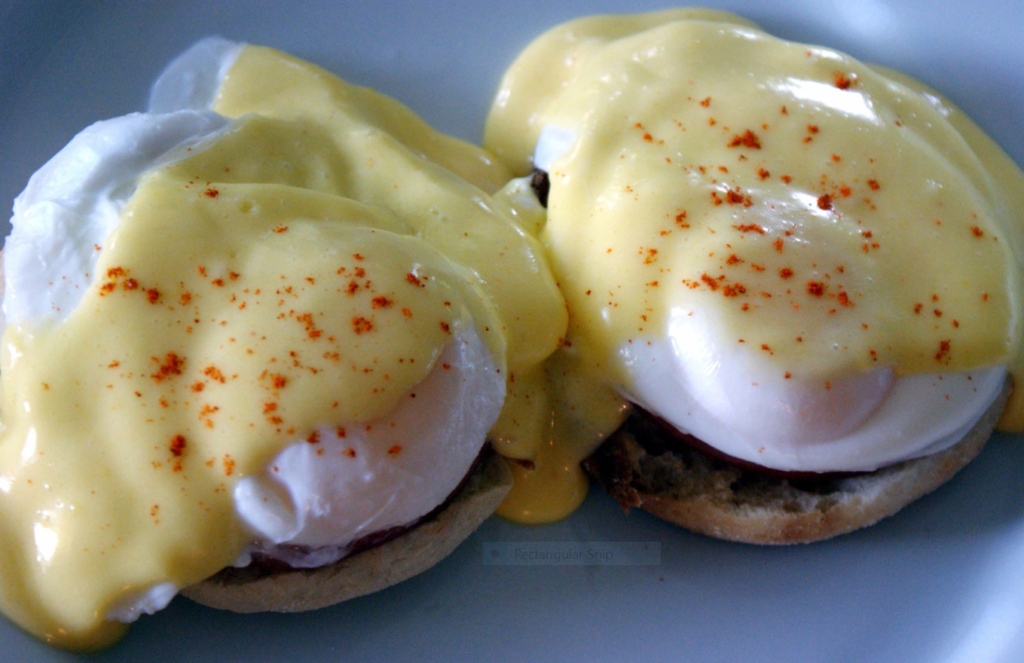
So imagine my surprise when I discovered that China, Hong Kong, and Macao all had Crumpets!
I actually had to do some unlearning at that stage. For me, the Lander’s brand of English muffin was the “Gold Standard”. I didn’t know that it was a mass-produced and down-sized crumpet for the American consumer. The English crumpet is actually larger, and thicker than their American cousins.
They were also fresher.
The crumpets were made locally, and thus they tended to be (at most) a few days old, as opposed to the American versions that were often weeks old. This resulted in a better taste. This also resulted in a greater appreciation for the crumpet that I did not have previously.
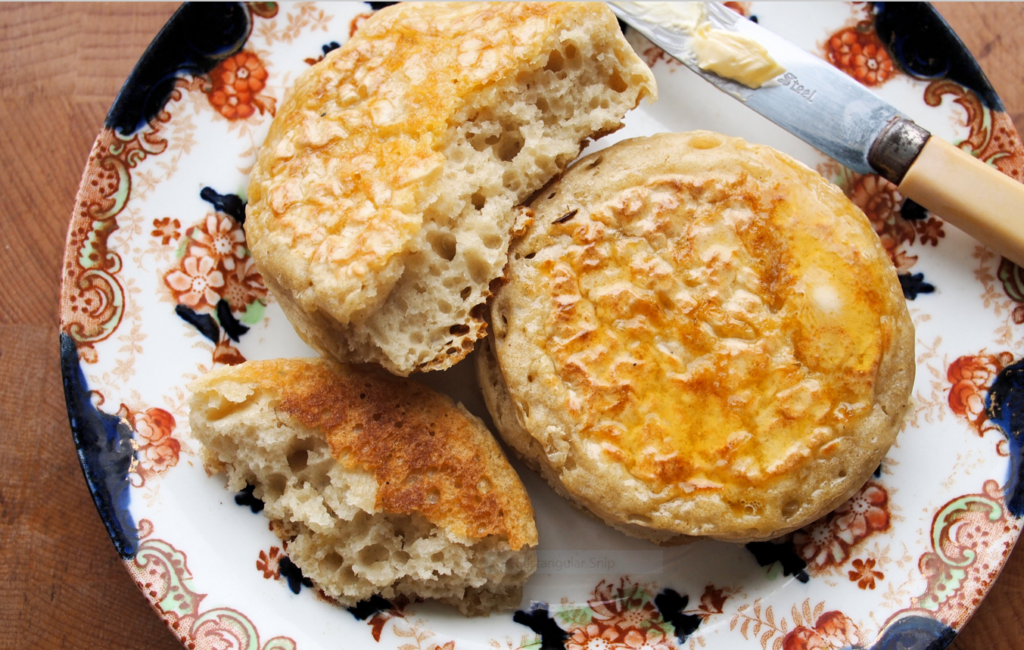
Since it is larger, it needs to be cut up into individual pieces to be eaten properly. The American version is tiny and you can eat it in the hand as a sandwich. You know, just like the famous McDonald’s breakfast sandwich is.
English Muffin Pizzas
I think everyone knows about this DIY hack. You make a mini-pizza out of an English Muffin. It’s a great little trick, and if you don’t know about it, then you are truly missing out.
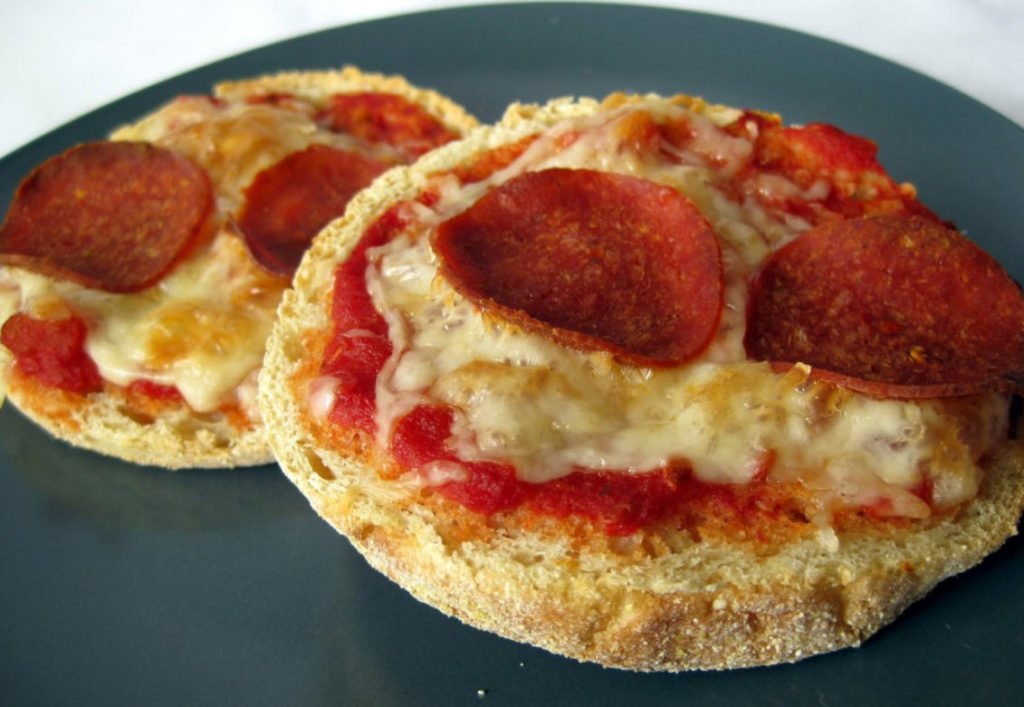
I was introduced to this DIY hack by a girl that I was dating in High School. I once visited her family while they were hanging out on a Friday night. (They had a house that they were building on the river. They were from Pittsburgh, and they were making the house to be a weekend home. They pretty much were living in the basement, while the father and uncles were building the upper floors.) I came over and was offered these amazing little mini-pizzas. At the time we were playing pool on their pool table. I fell in love with them the first time I took a bite.
They couldn’t get over the fact that I had never had one of these before.
However, the truth is that my family didn’t really make pizzas at home. At best we would get a frozen pizza, or a pizza kit and make up something. Pizza was a food that we would go to a restaurant for. At that time, the nearest “decent” pizza restaurant was all the way in Pittsburgh, which was a two-hour drive for us. So we only ate pizza on special occasions.
Then, when I was a Senior in High School, they opened up a Pizza Hut franchise in the nearby city of Butler, PA. Once that opened up we could get thin crust cheese and pepperoni pizza and a large pitcher of coke. I do wonder if they still offer that kind of pizza in Pizza Hut in the States today. I can tell you that, here in China, it is very hard to get a Pizza Hut thin-crust pepperoni pizza without paying extra for it. All the meals are pre-packaged “kits”. If you want something different, you will need to pay a premium for it.
Polish Bread Pizza
English Muffin Pizzas are very similar to a well-known (in my family) Polish food. Here we can talk about the Polish Open-Faced Sandwich (Zapiekanka). We eat Polish food as a way to explain our heritage to our children, and anyone else who wants to listen. Indeed, all Polish dishes serve as an opportunity for me to explain our Polish-American heritage.
Hey, I am Polish-American. Though I don’t hide behind it and ask for handouts like my liberal and progressive friends. I do try to keep some of the heritage alive.

Polish open-faced sandwiches (also known as French-bread pizzas) are popular street food in the bigger cities of Poland, not to mention my old family stomping ground in Pittsburgh (Polish Hill). They’re known as zapiekanki (plural) or zapiekanka (zah-peeyeh-KAHN-kah), which is singular. Most zapiekanki sandwiches start with French bread, sautéed mushrooms, cheese, and ketchup, but there are Greek-style with olives and feta cheese, Italian style and many more.
What makes the open-faced sandwich authentic is a thick drizzle of Polish ketchup across the top, no matter what cuisine the zapiekanka is trying to emulate. That’s the secret.
Home-made Submarine Sandwiches
How can we possibly talk about good fresh crusty bread without talking about subway sandwiches? Here, for those of you who are unaware like my wife (was), it is a sandwich that is made from an entire loaf of hard crusty bread and filled with cold cuts, cheese, and vegetables. There are variations that include meatballs (one of my favorites), shrimp, tuna, and lobster. It can be heated or eaten cold.
Needless to say, subway sandwiches are awesome!
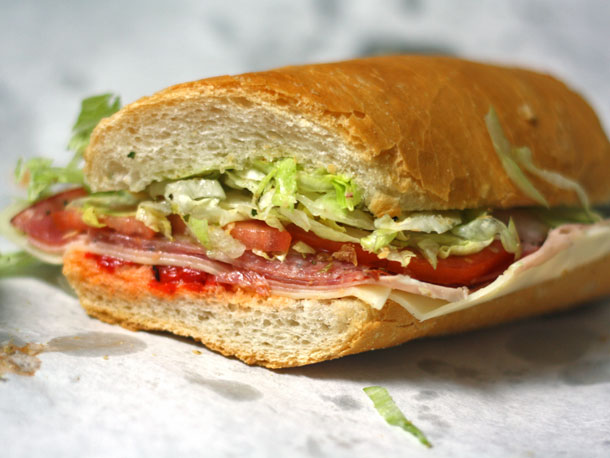
There are many kinds of subway sandwiches. There are “Hero sandwiches”, “Subway sandwiches”, “Hoagie”, “Grinder”, and “Po Boys”. It depends where you live.
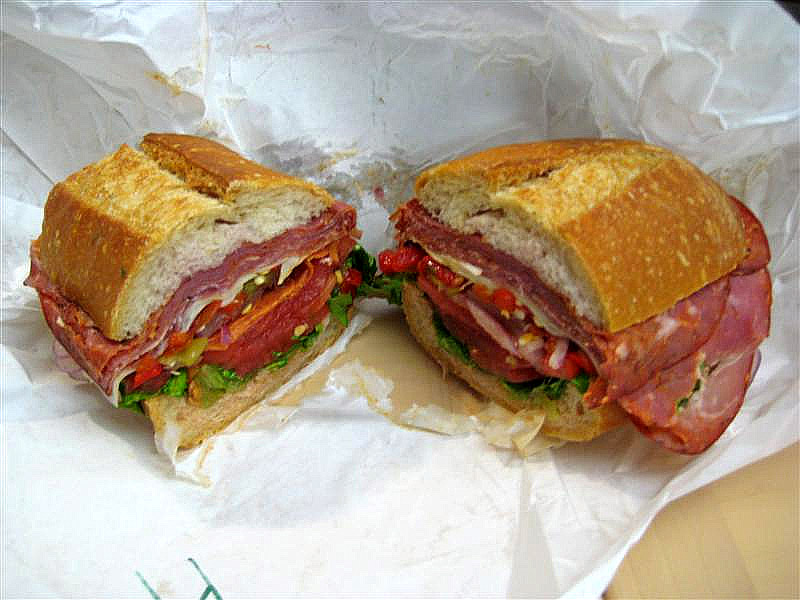
Sub sandwiches. This is short for Subway sandwiches. However, not every place know this. This is a pretty common way to ask for a submarine-style sandwich. If you were to go to a restaurant in the United States and asked for a “Sub Sandwich”, the chances are that they would know what you are talking about. Yet, if you start talking about a “Subway sandwich”, some places might actually not know what you are talking about at all.
Subway sandwiches. Many people know what a subway sandwich is because of the subway sandwich food chain. It is true shame that they have downsized and cut back on their business. I have always enjoyed the food and the fresh ingredients. I think that they are not appreciated as much as they should be.
Hero sandwiches. It’s another name for this most amazing of sandwiches. Personally, I think that it’s use is limited to certain geographic regions in the United States. In general, I would consider the term “Hero sandwich” to be a backup term for “Subway sandwich” that is in use in about 60% of the United States.
Hoagie sandwiches. The same is true for Hoagie sandwiches. It is a term that seems to be limited to certain sections of the United States. For the term “Hoagie”, it seems to be limited to the North East area. This is strange because this area also uses the terms “Grinder”, and “Torpedo” for these sandwiches.
Grinder. A “Grinder” is never called a “Grinder sandwich”. It is always a “grinder”. It is common in Massachusetts. In fact, the first time that I came across this term, I didn’t know what the heck they were talking about. You know, grinders can be egg and onion as well as the standard hoagie fare. When I ate grinders, the meat tended to be cut up in smaller pieces compared to what you would normally assume to see in a subway sandwich.
Wedge sandwich. This is a name that I am not at all familiar with.
Zeppelin sandwich. This also goes by the name of a “Zep sandwich” which is obviously a short form of ‘Zeppelin sandwich”. Apparently, it is common in West Central Pennsylvania, though I have never heard it used that much.
Torpedo sandwich. This is a regional name variant for a subway sandwich. I only heard it used once before in Tupelo, Mississippi. It was a scorcher of a day, and I went inside this small establishment at the side of the road and ordered a subway sandwich. They said “what?”, and then I explained it to them. Their response was, “oh, you mean a torpedo sandwich”. The sandwich was pretty good. It was a crawfish torpedo sandwich.
Po Boy Sandwiches. This is common in Mississippi and Louisiana. These are just different names for subway sandwiches, except that there tend to be more regional variations. In Mississippi, for instance, there would be catfish po boy sandwiches, lobster, and shrimp sandwiches as well as the normal selections that you might find elsewhere.
The joys of Rye Bread
One of the things that I miss (being here in China) is rye bread. It’s true. You can’t get rye bread anywhere.
Which is a real shame. Oh, how many times have I eaten a breakfast in the United States and the waitress asked me what kinds of bread that I would like to have, and I would choose wheat instead of rye because it was (supposedly) “healthier”. Really?
Why miss out on such great goodness? Because some “expert” conducted a “study” that stated that wheat bread was healthier for you to eat! Really! I was such a darn fool! I fell hook, line, and sinker for that nonsense!
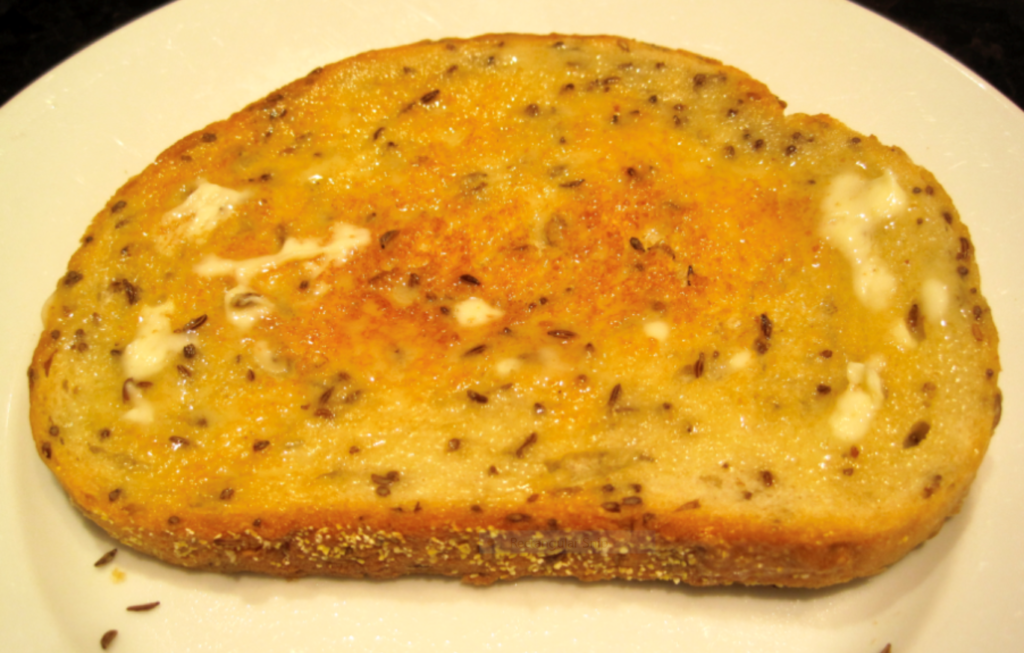
Look, next time you have an opportunity to eat toasted rye bread do it! Let those “experts” pontificate all they want. When it comes to your little enjoyments, I say let your hair down and indulge!
Potato Bread is best for Toast
Did you know the secret about potato bread? It’s perfect for toast. It really is. It makes the best crunchy bread out of the toaster. Who would figure? Eh? You might think that it would taste like a potato or something odd like that. But, it doesn’t.
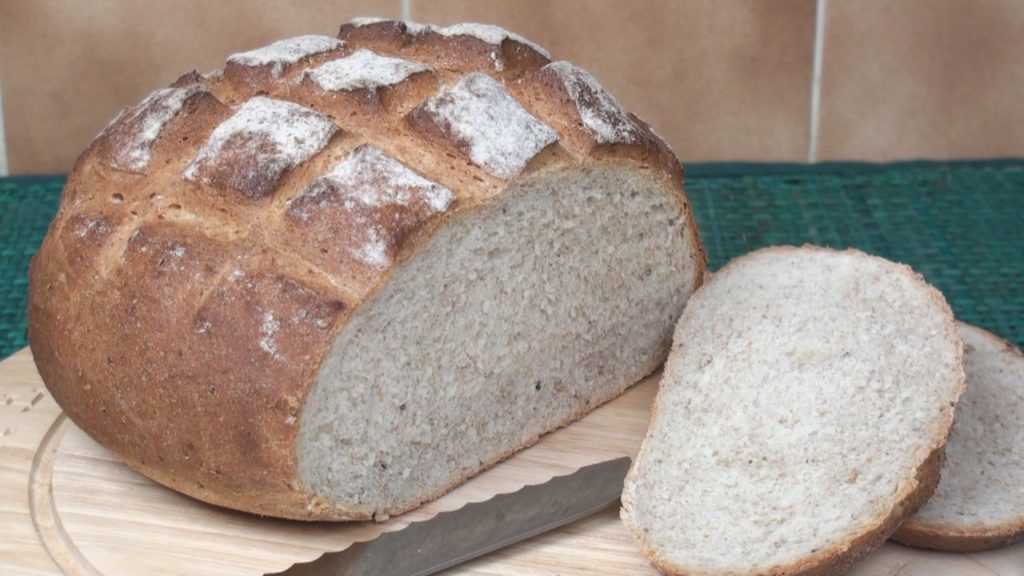
The first time that I ever tried this bread was through an argument with my mother. I must have been in my middle teen years and she was buying bread at the grocery store. I wanted some raisin bread, but I knew that she was tired of me asking every week for it (I was in a teenage phase at the time.). So I tried to be a little passive-aggressive. I told her, “Let’s try something different this time.”
So she bought a bag of potato bread.
Now, no one in the family would eat it. I didn’t and towards the end of the week, she complained that no one was eating the bread that she bought. So, out of guilt, I went and grabbed two slices and put them in the toaster. Wow! Was I surprised. The crust was so nice and even. It was even crunchier when toasted than regular white or wheat bread. Yet it was still soft and nice and warm inside.
It was amazing to me, and it quickly became one of my favorites at that time. That and pickle loaf from the deli. (BTW, it was a different time and different place, don’t you know.)
Coffee
Now, one of the things that I would like to do is enjoy a bagel (with creme cheese), or a well buttered fresh roll with a nice cup of coffee. Talking about coffee is something that I have reserved for another post. However, I would like to say a few words (just a small number, please) on the coffee cup that coffee is served in.
My words are simple, and my opinions are strong. Coffee should be served in a thick, bang on the counter-top, (off) white coffee mug. Anything less is a disservice to the drinker. I NEVER get a cup of coffee out of a paper cup (unless it is McDonalds) of course.

Bread in the ADC
For a period of time, I lived within the confines of the Arkansas Department of Corrections. This is also known as the “ADC”. We always had rough bread. The bread was made of a mixture of 50% white flour and 50% horse feed. Make no mistake here. I am not exaggerating.
While it is possible that this was done to save money, I would actually guess that it was done to create a “tough” environment inside the prison. Actually, how much money can you possibly save by buying horse feed instead of flour?
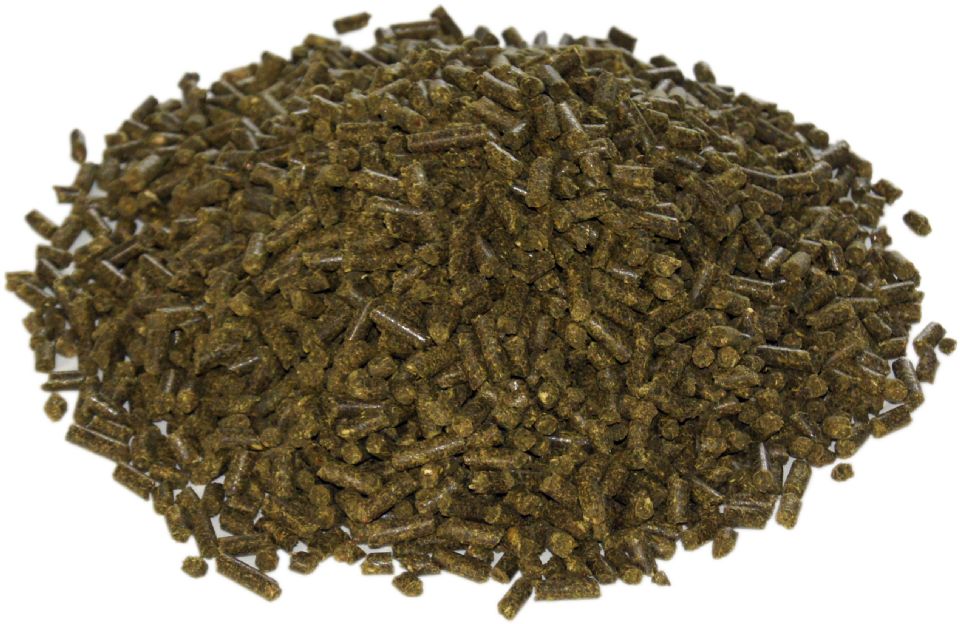
Therefore, I am convinced that it was done intentionally to create a very harsh environment to make prison as uncomfortable as possible. After all, when Bill Clinton (D) was Governor he set up the “Punishment” rules that that ADC now implements.
The bread was made from horse feed and whole-wheat flour. I know. I worked in the kitchen. It was written on the sacks that the feed came in. It said (in all bold letters, in Arial font) “NOT FOR HUMAN CONSUMPTION”.
The result was tough crunchy bread that belonged on Beowulf’s table. I laugh now, but the bags of food in the kitchen all were marked “not for human consumption” on them. I am sure that the prison officials would argue that this was not the case, but I can tell you that this is EXACTLY what we ate. I did work in the kitchen and I can attest to this fact.
In life, what is supposed to happen, and what actually happens are often diametrically opposed.
Just because something is not supposed to occur, does not prevent it from happening.
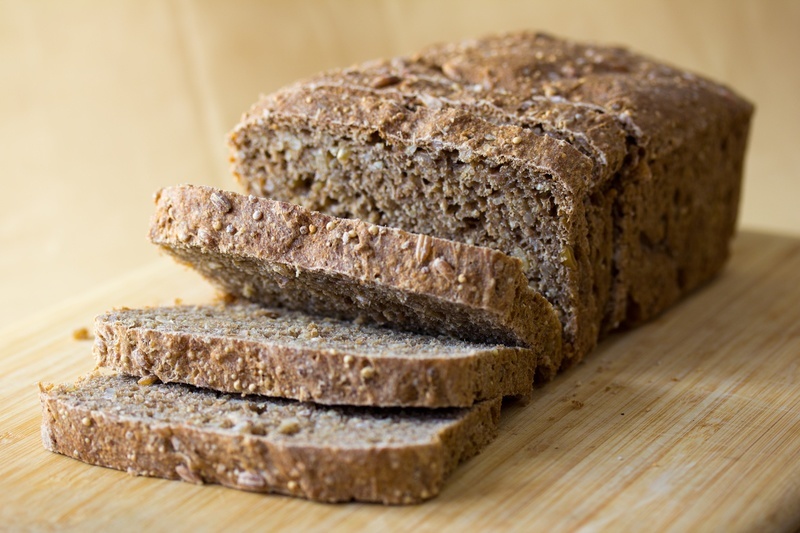
The bread was hardly tasty, and we only ate it as a last resort. It would hurt our teeth. Some inmates would take the bread and put it in their cup and fill it with milk. Then by adding something sweet like stewed tomatoes, or crushed up candy, they would be able to eat it as a kind of poor man’s dessert. We would never get fruit, ice cream, puddings or Jell-O. Those were truly luxury items for us.
The guards that worked the kitchen were generally humane and understood that they couldn’t always serve us gruel (in the ADC, they served us institutionalized gruel called “Global”.) After all, if they continued to do so, riots or worse might occur.
Life in prison was always a balance between how much punishment they could dish out before we would revolt. Thus they tended to break up the meals so that every day or so there would be biscuits made of real bread, or real meat, or decent vegetables as a side. It wasn’t always so horrible.
For instance, sometimes we got raw onions that we could mix with the beans. That was always a treat. Or at other times, we would get a hamburger and there might be a pickle or ketchup on the side so that we could make a sandwich. (Ah. Good times!)
The ADC always gave us a good great meal for Thanksgiving and Christmas. The same was true for the 4th of July. Truly, the guards were pretty decent folk. However, aside from the major holidays, some days were truly a waste of time marching down to the mess hall. We would grab the tray and just deposit it into the cleaning booth without even trying it.
Again…
You do not appreciate what you have until you lose it.
Summary
All this talk about bread… what’s the “big deal”?
You don’t appreciate things until you live without them. We take them for granted. Oh, sure you are far to busy to visit your grandparents today. maybe next month. Right? Yeah, sure, you can visit them next holiday. Not today. You have far too many things to do. After all, you are exhausted and tired, and just don’t feel up for the ride.
Oh, and a sandwich is just a sandwich. Why pay the extra two dollars at that nice family restaurant for a Montie Crisco sandwich, when you can go to McDonald’s and buy a number one meal effortlessly?

Besides, everything takes time. Everything costs a little bit more money. Everything comes with a cost. You can save money, and you can save time. You just go for fast-food. You just purchase the readily available “off the shelf” loaves of bread at the supermarket. It’s not a problem.
You can save the money and save the time…
The Montie Cristo sandwich is a simple example of what we deprive ourselves of in order to “improve” our lives. We sacrifice taste for convenience. We neglect our friends and family for the time that we can give to our employers. In the end, we just hurt and deprive ourselves.
Take Aways
- Bread is an underappreciated item.
- We sacrifice our time and our money on trivial things instead of devoting them to quality items.
- We do not appreciate things until we live our lives without them.
- We think and believe that what we have now will always be there for us.
- We need to appreciate what we have now, and relish it.
- I like fresh bread with salted butter with coffee.
- If there isn’t any coffee, a nice dry red wine, chardonnay or an ice cold beer would go great with fresh warm crusty bread.
FAQ
Q: What are loaves of bread like in China?
A: Typically, the Chinese manufacture commercial loaves of white bread for supermarkets just like what is done in the United States. However, there are some differences. Typically they are smaller at half the length. They also tend to be larger. Maybe 20% larger in size. They taste the same, however, which is like a bland sponge. They also make loaves of long Italian or French bread as well.
Q: What is the best kind of bread?
A: Fresh crusty bread, fresh out of the oven that is still hot. I like Italian, French and Russian loaves of bread. I think that bread is meant to be served warm and fresh. The idea that we can package week-old bread in a supermarket is an idea from the 1930’s that has really damaged the quality of meals in the United States over the last half of century or so.
Q: Why are sandwiches so popular?
A: Oh that is an easy question with an easy answer. Sandwiches are popular because they are made with bread. Fresh and toasty bread enhances everything… even vegetables.
Q: What is the best way to eat bread?
A: I personally believe that the best way to eat bread is to have it warm out of the oven (or reheated) and served with real salted butter.
RFH
I wonder if there is anyone out there who knows the secret for making hot warm crusty bread. My efforts have been complete failures. I really don’t know what I am doing wrong, but uniformly I just cannot bake bread at all. I really do not know what it is.
I guess that I am not made for making bread. I am just good for eating it.
Posts Regarding Life and Contentment
Here are some other similar posts on this venue. If you enjoyed this post, you might like these posts as well. These posts tend to discuss growing up in America. Often, I like to compare my life in America with the society within communist China. As there are some really stark differences between the two.
More Posts about Life
I have broken apart some other posts. They can best be classified about ones actions as they contribute to happiness and life. They are a little different, in subtle ways.
Stories that Inspired Me
Here are reprints in full text of stories that inspired me, but that are nearly impossible to find in China. I place them here as sort of a personal library that I can use for inspiration. The reader is welcome to come and enjoy a read or two as well.
Articles & Links
- You can start reading the articles by going HERE.
- You can visit the Index Page HERE to explore by article subject.
- You can also ask the author some questions. You can go HERE to find out how to go about this.
- You can find out more about the author HERE.
- If you have concerns or complaints, you can go HERE.
- If you want to make a donation, you can go HERE.
Notes
- Compiled at first draft 19MAY18.
- SEO review 19MAY18.
- Edited by request 19MAY18.
- Release 19MAY18.
- Updated featured image 20JUL18.

